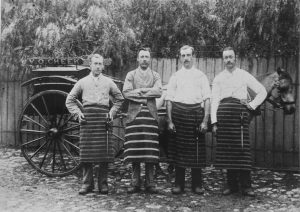Following on from the previous edition, honorary curator Peter Foster continues to explore his favourite category in the National Trust horse-drawn vehicle collection – the tradesman’s vehicles that delivered provisions to South Australian households.
Leaving the bakers to continue down Ivy Street with a delivery of fresh loaves and those round tantalising fruit buns, let’s take a closer look at other well-known types of commercial or tradesman’s vehicles. The milkman was often heard but rarely seen clip-clopping on his rounds in the mist of early mornings, like an image from a Clarice Beckett painting. This choice of delivery time was necessitated by the milk production chain and a lack of reliable refrigeration.
The earlier milk carts or floats, as they were sometimes known, could be either two or four-wheeled, the latter identical in design to those used by bakers. This style was a product of the early 1930s with pneumatic car wheels. The milk floats, however, had a full-length rear door and no shelving, which allowed easy access and space for large milk cans. The collection has fine examples of the two types – a two-wheeled, chariot-styled vehicle and a motor-wheeled version believed to have been used by the Thain family in Adelaide up until the early 1960s.
Of the collections three butcher carts, the oldest was owned and used by the Kernich family in the small Barossa Valley town of Greenock. Ted Kernich operated the butcher shop and its delivery service from 1905 with two carts. The surviving vehicle was donated to the collection in the 1960s, having ceased deliveries in 1950. As with the baker’s vans explored in the previous article, these trade vehicles, by design, had a series of large flat panels allowing significant space for advertising, which were more than adequate for coach painters, signwriters and liners to display colourful, bold lettering, artwork and intricate scrollwork. Famous Heidelberg artist Frederick McCubbin, while an apprentice in the employ of Melbourne coachbuilders Stevensen and Elliotts, found these vehicles an outlet for his developing skills.
New addition to collection
While carts used by butchers, bakers and milkmen seem to be among the trade vehicles most remembered, there were others. Among the so-called delivery carts was another essential vehicle – the fruiterer’s van. These vehicles, four-wheeled with a canvas top and racks inside to carry both fruit and vegetables, were drawn by one horse. After some time in the restoration workshop, the collection now has on display at Millicent a market gardener’s wagon. It differs from the fruiterer’s van in name only. This vehicle originated in Penola and was used by Jimmy Ah Suee to deliver his produce to that town and others nearby. Like many Chinese, he was known for his quality produce, both vegetables and fruit, grown on land that formed part of the Penola Fruit Colony (later renamed Coonawarra), established by John Riddoch in 1890.
In January 1892, The Border Watch newspaper reported: ‘On Saturday last the first load of marketable vegetables, etc., grown at the Penola fruit colony were brought into town, and disposed of by that enterprising townsman, Ah Suee. Ah Suee has taken up a ten-acre block, and combined with fruit-growing, he is carrying on the usual “Chinese garden”. The vegetables in question comprise a very good collection of all that are usually obtainable at this time of the year, and although “James” has only been on his block about six months, he is already enjoying a profitable return from his outlay of labour and capital.”
This vehicle is a welcome addition to the National Trust’s horse-drawn vehicle collection, being local in origin while underlining an important aspect of Chinese-Australian history.
The collection of horse-drawn vehicles held by the National Trust of South Australia is regarded as Australia’s finest. Featuring some 90 restored and conserved items, it is held at the Millicent Museum. For more information and opening times visit nationaltrust.org.au/places/millicent-museum/
The Cheek family of butchers, St Peter’s, 1888 (State Library of SA B 28662).
The collection’s chariot-style dairy cart used by Springbank Dairy, Clarence Park (photo by John Nieddu).
The Kernich family butcher’s cart (photo by John Nieddu).

